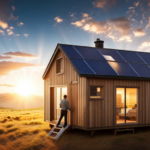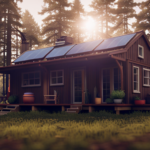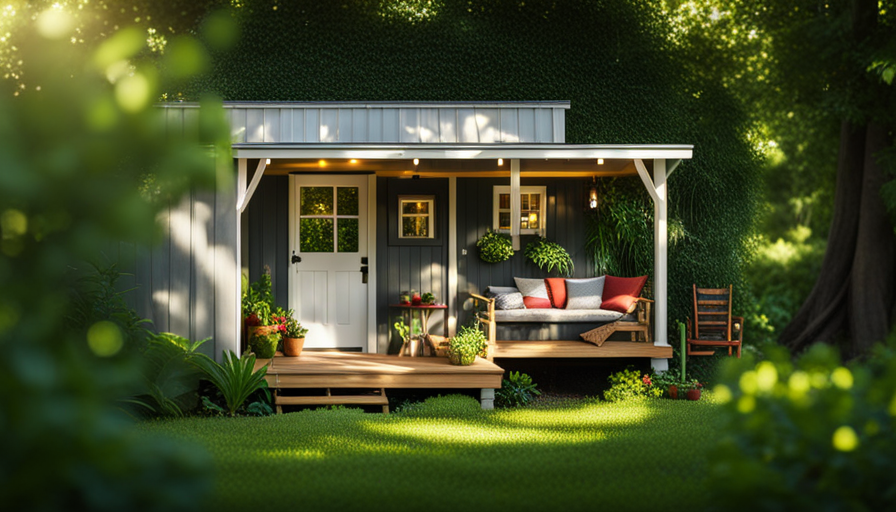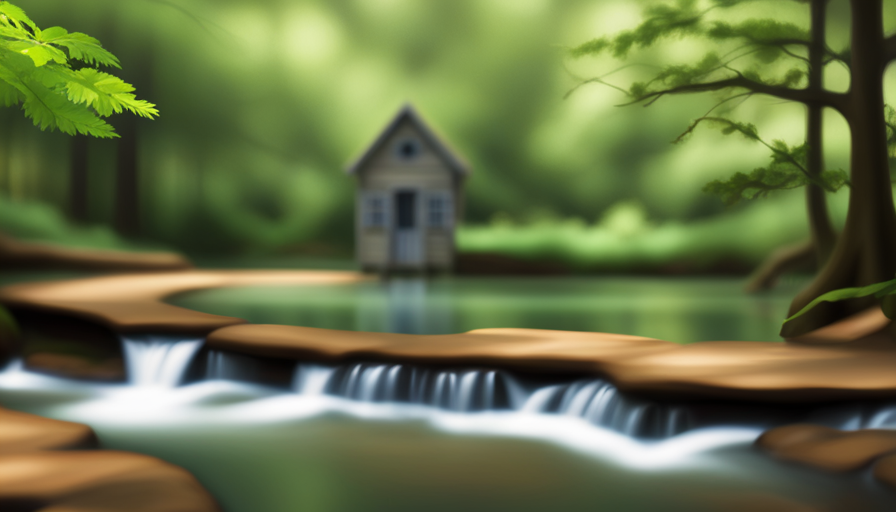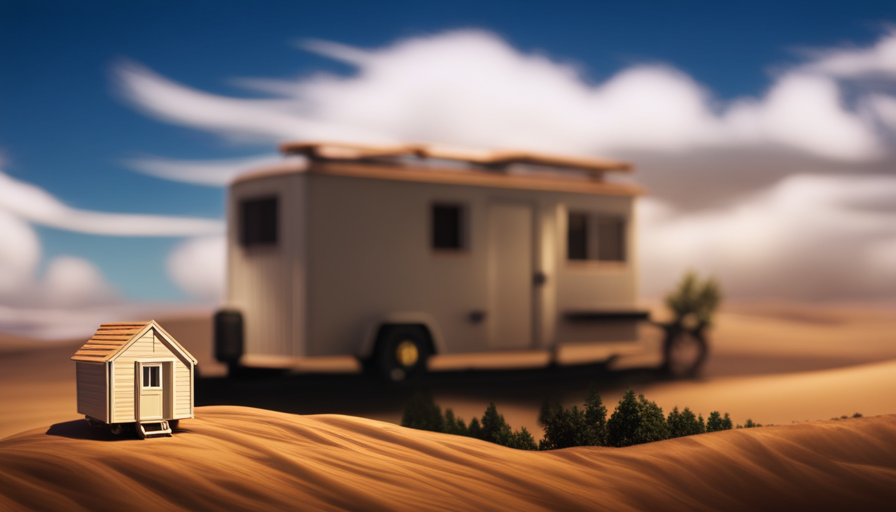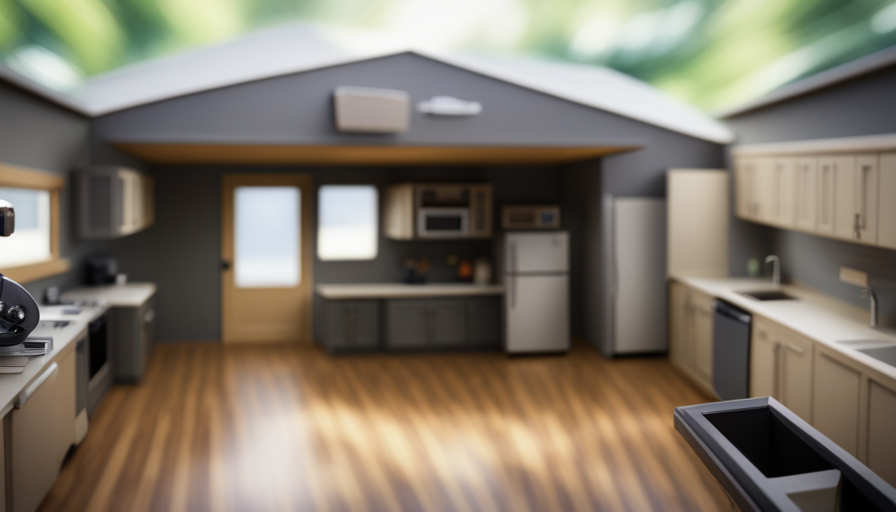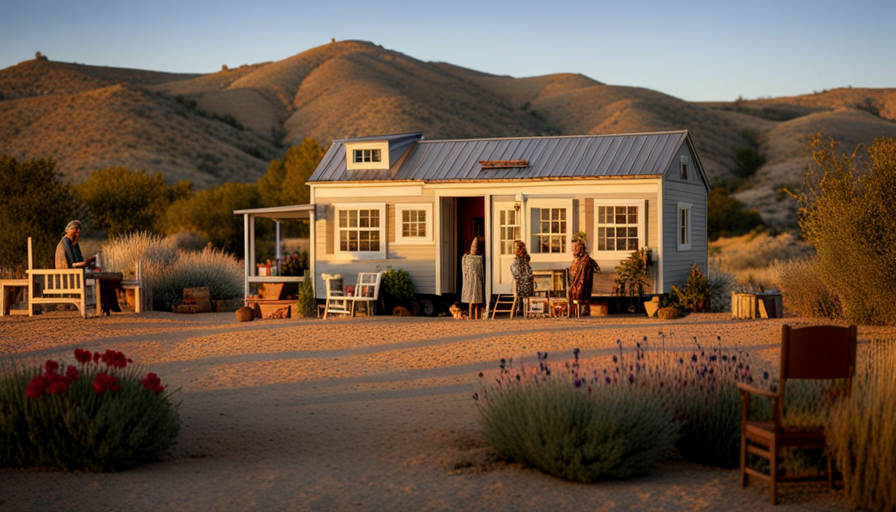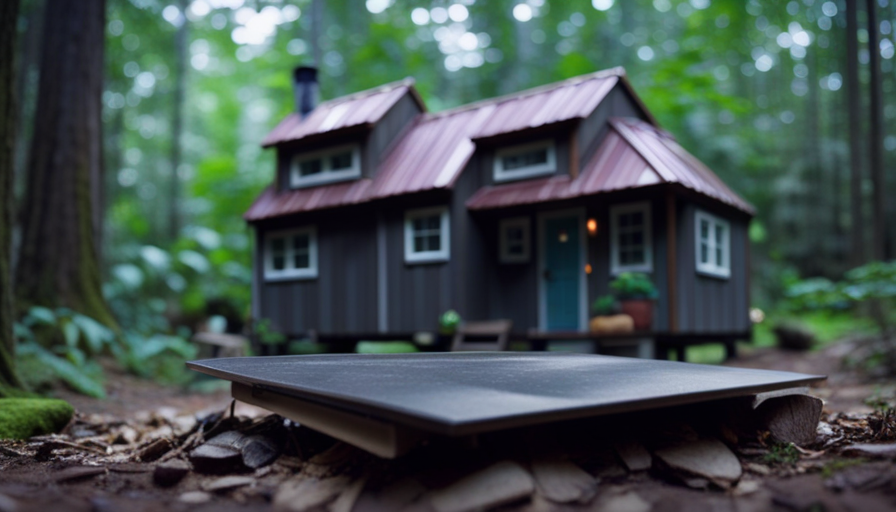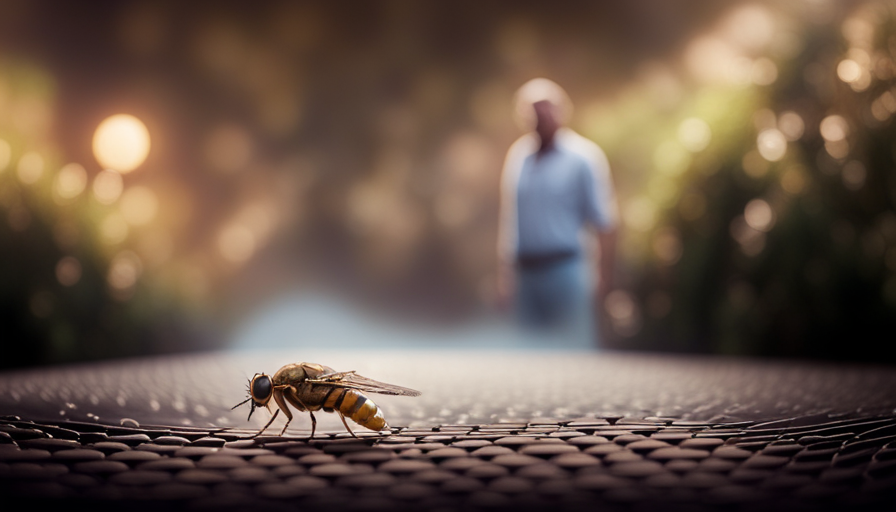When it comes to off-grid living in a small home, choosing the right power source is crucial. Thankfully, there are numerous sustainable and efficient options to consider.
In this article, I will explore various methods to power a tiny house off-grid, providing you with the knowledge and practical advice needed to make an informed decision.
Harnessing the power of the sun through solar panels is a popular choice for tiny house owners. By converting sunlight into electricity, you can power your home while reducing your environmental impact.
Another renewable energy option is wind power, which utilizes wind turbines to generate electricity. If you have access to a water source, hydroelectric power can be a sustainable and reliable energy source. Biomass power, derived from organic waste, is another viable option.
In addition to renewable energy sources, utilizing clean-burning fuels like propane or natural gas can provide a consistent and efficient power supply. Composting toilets offer a sustainable waste management solution, while rainwater harvesting allows you to collect and use rainwater for various needs.
Finally, energy-efficient appliances and lighting, along with conservation and efficiency measures, can help maximize energy usage.
By implementing these techniques, you can power your tiny house off-grid in a way that is both environmentally friendly and practical.
Key Takeaways
- Solar panels and wind turbines are popular renewable energy options for off-grid tiny house living.
- Composting toilets offer a sustainable waste management solution for tiny houses.
- Rainwater harvesting provides a sustainable water source for off-grid tiny houses.
- Energy-efficient appliances and lighting help maximize energy usage in tiny houses.
Solar Power: Harness the Sun’s Energy for Electricity
You can easily power your tiny house off-grid by harnessing the sun’s energy with solar power! Solar panel installation is a simple and effective way to generate electricity for your tiny house.
By installing solar panels on your roof or in a sunny area nearby, you can capture the sun’s rays and convert them into usable electricity. This renewable energy source has numerous benefits, including reducing your carbon footprint, lowering your energy costs, and providing a reliable power source even in remote locations. Solar power is also low maintenance and requires minimal upkeep once the panels are installed.
Transitioning to the next section about wind power, utilizing wind turbines for renewable energy is another great option to consider for powering your tiny house off-grid.
Wind Power: Utilize Wind Turbines for Renewable Energy
When it comes to harnessing wind power for renewable energy, there are a few key points to consider.
First, it’s important to choose the right wind turbine size for your needs. This will depend on the amount of electricity you want to generate and the space available for installation.
Secondly, you’ll need to take into account the wind conditions and location of your site. Factors such as average wind speed, turbulence, and obstructions can all affect the performance of your wind turbine.
By carefully considering these factors, you can ensure that you make the most efficient use of wind power for your off-grid tiny house.
Choosing the Right Wind Turbine Size
Imagine the exhilaration of harnessing the perfect wind turbine size, propelling your tiny house into a realm of sustainable, off-grid living. When it comes to wind power, choosing the right turbine size is crucial for maximizing efficiency and minimizing maintenance. A larger turbine may generate more electricity, but it requires stronger winds to operate efficiently. On the other hand, a smaller turbine may be more suitable for areas with lower wind speeds, but it may not produce enough power to meet all your needs. To help you make an informed decision, consider the following factors when selecting a wind turbine size:
| Factors | Considerations |
|---|---|
| Wind conditions | Evaluate the average wind speed and direction in your location. |
| Power requirements | Determine how much electricity your tiny house needs. |
| Space limitations | Consider the available space for installation. |
By carefully considering these factors, you can choose the right wind turbine size that best suits your specific needs and location.
Considering Wind Conditions and Location
Evaluate the available wind conditions and location to determine the most suitable wind turbine size for your sustainable living setup. When considering wind conditions, it’s important to assess the average wind speed and direction in your area. Higher wind speeds generally result in greater wind turbine efficiency.
Additionally, the terrain and obstacles surrounding your location can affect wind patterns, so take those into account as well. Maintenance is another crucial aspect to consider. Regular maintenance of your wind turbine is essential to ensure optimal performance and longevity. This includes inspecting and cleaning the turbine, lubricating moving parts, and checking for any damage or wear.
By evaluating wind conditions and location, as well as considering wind turbine maintenance, you can make an informed decision on the right wind turbine size for your off-grid tiny house. Transitioning to the next section, let’s explore how to tap into water as a sustainable energy source with hydroelectric power.
Hydroelectric Power: Tap into Water as a Sustainable Energy Source
To power a tiny house off-grid, one can tap into the sustainable energy source of hydroelectric power by utilizing the force of flowing water. Hydroelectric power, also known as hydro energy, harnesses the kinetic energy of moving water and converts it into electricity. This renewable energy source is not only abundant but also eco-friendly, making it an ideal choice for powering a tiny house in a sustainable manner.
To understand how hydroelectric power works, let’s take a look at the table below:
| Pros | Cons | Considerations |
|---|---|---|
| Clean and renewable | High initial cost | Water availability |
| Minimal greenhouse gas emissions | Environmental impact | Terrain suitability |
| Long lifespan of equipment | Limited location options | Regulatory permits |
By considering the pros and cons of hydroelectric power, one can determine if this energy source is suitable for their tiny house project. However, it’s important to note that hydroelectric power is just one option for off-grid living. In the next section, we will explore another sustainable energy source: biomass power, which involves converting organic waste into energy.
Biomass Power: Convert Organic Waste into Energy
Let’s explore how we can convert organic waste into energy with biomass power. Biomass power is a sustainable way to manage waste by converting it into a valuable energy source.
Organic waste, such as agricultural residue, food scraps, and yard trimmings, can be processed through various methods like anaerobic digestion or combustion to produce heat and electricity. This process not only reduces the amount of waste going to landfills but also provides an environmentally friendly alternative to fossil fuels.
Biomass power plants can be set up at a community or individual level, making it a viable option for powering a tiny house off-grid. By harnessing the energy potential of organic waste, we can create a more sustainable and self-sufficient living environment.
Now, let’s move on to the next section and explore how we can utilize clean-burning fuels like propane or natural gas.
Propane or Natural Gas: Utilize Clean-Burning Fuels
When it comes to powering a tiny house off-grid, there are several fuel options to consider. In the previous subtopic, we explored the conversion of organic waste into energy through biomass power.
Now, let’s compare two popular fuel options: propane and natural gas. Both are clean-burning fuels that can efficiently power a tiny house. Propane is a versatile fuel that can be used for cooking, heating, and generating electricity. It’s readily available and can be stored in tanks for long periods.
On the other hand, natural gas is a cleaner energy source that can be easily converted from propane. Switching to natural gas offers environmental benefits and reduces greenhouse gas emissions.
It’s important to weigh the advantages and disadvantages of each fuel option based on your specific needs and the availability in your area.
Now, let’s delve into the next section about micro-hydro power and harnessing the energy from small streams or rivers.
Micro-Hydro Power: Utilize Small Streams or Rivers for Energy
Harness the power of small streams or rivers to generate energy for your compact living space with micro-hydro power. Micro hydro power systems offer several benefits, including a reliable and consistent source of renewable energy.
Here’s a step-by-step guide to installing a micro hydro power system:
-
Assess your site: Find a suitable location on your property where the stream or river has a consistent flow.
-
Determine the water flow and head: Measure the flow rate and the vertical drop, or head, of the water to calculate the potential power output.
-
Select the appropriate equipment: Choose a micro hydro turbine and generator that match your site’s characteristics.
-
Install the system: Set up the turbine, generator, and transmission components, ensuring proper alignment and connection.
Micro hydro power systems have their limitations, such as the need for a suitable water source and the potential impact on aquatic ecosystems.
Transitioning to the next section, let’s explore composting toilets as a sustainable waste management solution.
Composting Toilets: Sustainable Waste Management Solution
When it comes to sustainable waste management in a tiny house, composting toilets are a game changer.
There are various types of composting toilets available, each with its own unique features and benefits.
Proper maintenance is essential to ensure efficient decomposition of waste, and implementing odor control measures is crucial for a pleasant living environment.
Types of Composting Toilets
Composting toilets offer a sustainable and eco-friendly solution for waste management in tiny houses. They not only reduce water usage but also allow for the conversion of waste into usable compost. There are several types of composting toilets available, each with its own unique features and benefits.
-
Self-contained systems: These toilets are compact and easy to install, making them ideal for small spaces.
-
Central systems: These toilets are connected to a central composting unit, which can handle waste from multiple toilets.
-
Batch systems: These toilets separate urine from solid waste, allowing for faster and more efficient composting.
-
Vermicomposting toilets: These toilets use worms to break down waste, creating nutrient-rich compost.
-
DIY systems: For those who enjoy a hands-on approach, building a composting toilet from scratch can be a rewarding and cost-effective option.
Proper maintenance and odor control are essential for the successful operation of composting toilets.
Proper Maintenance and Odor Control
To keep your composting toilet functioning smoothly and ensure a fresh-smelling environment, regular upkeep and effective odor management are crucial.
Here are some proper maintenance tips to help you maintain your composting toilet. Firstly, it’s important to regularly empty the solid waste container and add a layer of composting material to promote decomposition.
Additionally, check and clean the ventilation system regularly to prevent any blockages that could lead to odors. Using a composting accelerator can help speed up the decomposition process and reduce odors.
Lastly, make sure to keep the toilet lid closed when not in use to prevent any odors from escaping.
By following these proper maintenance tips, you can eliminate odors effectively and maintain a pleasant environment in your tiny house.
Moving on to the next section about rainwater harvesting, you can collect and use rainwater for various needs.
Rainwater Harvesting: Collect and Use Rainwater for Various Needs
When it comes to living off-grid in a tiny house, one of the key challenges is finding a sustainable water source. That’s where rainwater harvesting comes in.
Installing a rainwater collection system allows me to collect and store rainwater for various needs, from flushing the toilet to watering plants. And to ensure the water is safe for use, I can filter and treat it using simple techniques such as sediment filters and UV sterilizers.
Installing a Rainwater Collection System
Installing a rainwater collection system will allow you to easily and sustainably supply your tiny house with water, reducing your reliance on traditional water sources.
To begin, there are several types of rainwater filters you can choose from, such as mesh filters, sediment filters, and carbon filters. These filters are essential for removing debris, sediment, and potential contaminants from the collected rainwater.
Additionally, you can create a DIY rainwater collection system using materials like gutters, downspouts, and a storage tank. This system will help efficiently direct rainwater into the tank, where it can be stored for later use.
By installing a rainwater collection system, you can ensure a constant supply of water for your tiny house, while minimizing your impact on the environment.
In the next section, we will explore the importance of filtering and treating rainwater for safe use.
Filtering and Treating Rainwater for Safe Use
Filtering and treating rainwater ensures that the water you collect is safe and clean for everyday use in your cozy home.
There are various rainwater filtration techniques available to remove impurities and contaminants from the collected water. One popular method is using a sediment filter to remove larger particles, followed by a carbon filter to eliminate odors and improve taste. Additionally, UV sterilizers can be used to kill bacteria and other microorganisms.
After filtration, it’s important to store the treated rainwater properly. Rainwater storage solutions include tanks, barrels, and cisterns that can hold large amounts of water for later use. These storage systems should be properly sealed to prevent contamination.
By filtering and treating rainwater and storing it correctly, you can have a sustainable and reliable water source for your tiny house.
Transitioning into the next section, energy-efficient appliances and lighting help reduce energy consumption in your off-grid home.
Energy-Efficient Appliances and Lighting: Reduce Energy Consumption
When it comes to reducing energy consumption in a tiny house, there are a few key points to keep in mind. First, choosing Energy Star rated appliances can make a big difference in efficiency. These appliances are designed to use less energy without sacrificing performance.
Second, using LED lighting throughout the house can also greatly increase efficiency. LED bulbs use significantly less energy than traditional incandescent bulbs and can last much longer.
By implementing these two strategies, you can significantly reduce your energy consumption in a tiny house.
Choosing Energy Star Rated Appliances
By opting for Energy Star rated appliances, you can unlock a world of eco-friendly efficiency and savings, turning your tiny house into a powerhouse of green living. Energy Star certification ensures that appliances meet strict energy efficiency guidelines set by the U.S. Environmental Protection Agency.
These appliances are designed to consume less energy, reducing your carbon footprint while saving you money on energy bills. Energy efficient design features such as improved insulation, advanced cooling systems, and smart technology allow Energy Star appliances to perform optimally while using less electricity.
From refrigerators and dishwashers to washers and dryers, Energy Star rated appliances offer superior performance while consuming significantly less energy. This not only benefits the environment but also helps you live a sustainable lifestyle. When combined with using LED lighting for efficiency, you can create a truly energy-efficient tiny house that maximizes energy savings and minimizes environmental impact.
Using LED Lighting for Efficiency
Using LED lighting in your small sanctuary will illuminate your space with a soft, energy-efficient glow, creating a cozy and eco-friendly atmosphere. LED lighting offers numerous benefits for off-grid living.
Firstly, it consumes significantly less energy compared to traditional incandescent bulbs, allowing you to maximize your energy resources. LED lights also have a longer lifespan, reducing the need for frequent replacements. Additionally, they emit less heat, making them safer and more comfortable to use in a tiny house.
When choosing LED bulbs, opt for those with the Energy Star label, ensuring they meet strict efficiency standards.
By incorporating LED lighting into your off-grid living, you can enjoy the benefits of energy-saving lighting options while minimizing your environmental impact.
Transitioning into the subsequent section about conservation and efficiency measures, let’s explore how to maximize energy usage in your tiny house.
Conservation and Efficiency Measures: Maximize Energy Usage
When it comes to maximizing energy usage in a tiny house, two key points to consider are insulating and sealing the space properly, as well as implementing smart home technology for energy management.
Insulating and sealing the tiny house is crucial in order to prevent heat loss during the colder months and keep the space cool during the hotter months.
Additionally, implementing smart home technology allows for better control and management of energy usage, optimizing efficiency and reducing waste.
Insulating and Sealing the Tiny House
Insulating and sealing the tiny house is essential for creating a cozy and energy-efficient living space. By employing effective insulating techniques, such as using high-quality insulation materials and sealing any gaps or cracks, we can prevent heat loss during the winter and keep the interior cool during the summer. Additionally, proper moisture control is crucial to avoid mold and moisture-related issues. To help visualize the importance of insulation and sealing, let’s take a look at this table:
| Insulating Techniques | Benefits |
|---|---|
| High-quality insulation materials | Improved energy efficiency |
| Sealing gaps and cracks | Prevention of drafts and heat loss |
| Proper moisture control | Avoidance of mold and moisture-related issues |
Implementing smart home technology for energy management is the next step in creating an off-grid tiny house. By incorporating energy-saving devices and automated systems, we can further optimize energy usage and enhance sustainability.
Implementing Smart Home Technology for Energy Management
To optimize your energy usage and enhance sustainability, it’s time to bring in the magic of smart home technology for managing energy in your cozy abode. Implementing smart home automation and energy monitoring systems can significantly increase the efficiency of your off-grid tiny house.
Here are three ways smart home technology can help:
-
Smart Thermostats: These devices learn your preferences and adjust the temperature accordingly, saving energy when you’re not home and ensuring comfort when you are.
-
Energy Monitoring Systems: By tracking your energy consumption in real-time, you can identify areas where you can reduce energy usage and make adjustments accordingly.
-
Smart Lighting: With smart bulbs and switches, you can control your lights remotely, set schedules, and even sync them with natural light, optimizing energy usage throughout the day.
Incorporating smart home technology into your off-grid tiny house allows for intelligent energy management, reducing waste, and ultimately helping you live a more sustainable lifestyle.
Frequently Asked Questions
How much does it cost to install a solar power system for a tiny house?
Installing a solar power system for a tiny house can vary in cost depending on factors such as the size of the system and location. However, when compared to other off-grid power options, solar power offers significant benefits. It’s a clean and renewable energy source that can save you money in the long run by reducing or eliminating electricity bills. Additionally, solar power systems require minimal maintenance and can increase the value of your tiny house.
Can wind power be used as the sole source of energy for a tiny house?
Wind power can be a viable option for powering a tiny house off-grid, but it’s important to consider its pros and cons.
Like a steadfast lighthouse, wind turbines offer a renewable energy source. However, their efficiency can vary depending on the location and wind patterns.
The benefits include no fuel costs and minimal maintenance, while drawbacks include noise and visual impact.
To maximize efficiency, it’s advisable to combine wind power with other renewable sources like solar energy.
What are the maintenance requirements for a micro-hydro power system?
Maintenance requirements for a micro-hydro power system are crucial to ensure its efficiency and longevity. Regular inspections of the turbine, generator, and electrical connections are necessary to detect any potential issues.
Cleaning debris from the intake screens and adjusting the flow rate are also important. Safety precautions, such as wearing protective gear and following proper installation procedures, should be followed.
It’s advisable to have a professional technician conduct periodic maintenance to ensure optimal performance and prevent any potential hazards.
Are there any limitations to using composting toilets in a tiny house?
There are some limitations to using composting toilets in a tiny house, but they also come with several benefits. One limitation is that composting toilets require regular maintenance and turning of the compost pile. Additionally, they may have a slight odor, although this can be minimized with proper ventilation.
However, composting toilets are a great option for off-grid living as they save water, eliminate the need for a septic system, and provide nutrient-rich compost for gardening.
How much rainwater can be harvested and stored for a tiny house?
When it comes to rainwater harvesting for a tiny house, the capacity and storage options are crucial. You’ll be amazed by the amount of rainwater that can be harvested, providing a sustainable water source.
With a well-designed system, you can collect and store a significant amount of rainwater. Various storage options like tanks and barrels are available, making it convenient to utilize the harvested rainwater for various purposes.
It’s a practical and eco-friendly solution for off-grid living.
Conclusion
In conclusion, powering a tiny house off-grid is not only possible, but it’s also a sustainable and practical choice. By harnessing the sun’s energy through solar power and utilizing wind turbines, we can create a self-sufficient and eco-friendly home.
Tapping into water as a source of energy and converting organic waste into biomass power are additional ways to power a tiny house off-grid. Using clean-burning fuels is another option to consider.
Implementing composting toilets, rainwater harvesting, energy-efficient appliances, and lighting, as well as conservation measures, can further reduce our environmental impact.
With these innovative solutions, we can truly live off-grid and make a positive difference in the world. It’s a game-changer!
Hi, I’m Emma. I’m the Editor in Chief of Tiny House 43, a blog all about tiny houses. While tree houses are often associated with childhood, they can be the perfect adult retreat. They offer a cozy space to relax and unwind, surrounded by nature. And since they’re typically built on stilts or raised platforms, they offer stunning views that traditional homes simply can’t match. If you’re looking for a unique and romantic getaway, a tree house tiny house might just be the perfect option.






